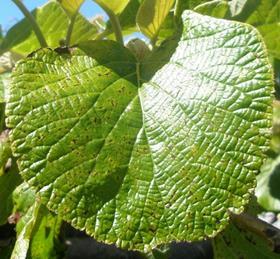
New Zealand’s kiwifruit industry received a blow last night when the publication of test results confirmed the presence of Pseudomonas syringae pv Actinidiae (PSA) in a North Island orchard.
The orchard was quarantined on Monday, with a second orchard located adjacent to it quarantined on Wednesday.
News of the test results was issued in a press release from MAF Biosecurity New Zealand (MAFBNZ), which added that more tests were being conducted to confirm the strain of the disease.
MAFBNZ inspectors and leading New Zealand bacteriologists have conducted a site examination at the orchard where the infection was discovered, and are now working to better understand and control the spread of the disease.
Zespri CEO Lain Jager told Fruitnet.com it was impossible to foresee how the disease might affect the industry in New Zealand until more was known about its particular strain, how long it has been in the country and how widespread it is.
The bacterial disease has already caused extensive damage to kiwifruit production in Italy, where it was first discovered in 1992. The outbreak there has intensified over the past year, taking an even stronger hold on production, notably in Italy’s main kiwifruit production area in Lazio but also further north in Emilia-Romagna. Yellow-fleshed kiwifruit has proven particularly susceptible, with an estimated 9m euros of sales forecast to be lost this season alone in Lazio as a result of this year’s outbreak.
Zespri is only too familiar with the problem, since it has claimed large swathes of its Gold kiwifruit plantings in Italy, the Northern Hemisphere country that underpins its off-season supplies. “There’s been a severe impact on the Gold crop in Italy,” Mr Jager confirmed. “Over half of the production over there (in Latina) has been affected.”
The fact that the Gold variety (Hort16A) now forms a key part of New Zealand’s kiwifruit production is a cause for concern, Mr Jager added.
Green kiwifruit, meanwhile, has shown a greater resistance to PSA in Italy and other parts of the world. Indeed, Japan, where the disease was first indentified on kiwifruit vines 25 years ago, has been able to keep it under control and maintain production through appropriate agricultural practices.
Besides the potential impact on New Zealand’s production, there are also major implications in terms of market access. MAFBNZ has already informed the country’s trading partners of the situation, Mr Jager noted.
“From a market access point of view, PSA is already present in Japan, Korea and Italy, but some markets could close their borders,” he said. “China is a potential risk in that regard.”
Whatever the outcomes, the impact for the current season is likely to be limited as the export campaign is almost over.
Zespri is currently seeking to gauge how widespread the disease issue may be in orchards. The company has instructed growers to check orchards for symptoms of PSA and issued them with a detailed information sheet with clear protocols explaining how to identify symptoms and what measures to take. It has also urged them to step up orchard hygiene, which is a critical issue in preventing the movement of any bacteria from infected to uninfected orchards given that the bacteria spreads through the air.
Kiwifruit represents New Zealand’s largest horticultural export industry, with an annual value estimated at some NZ$1.5bn.



